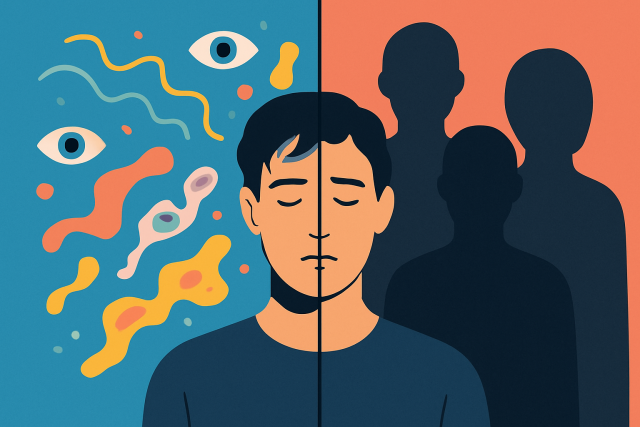
What Is IED Disorder And How Does It Affect Behavior?
Intermittent Explosive Disorder (IED) causes sudden, intense anger outbursts that affect relationshi...
Understanding schizoaffective disorder symptoms can feel like solving a puzzle since they combine features from both schizophrenia and mood disorders such as depression or bipolar disorder.
Schizoaffective disorder is a mental health condition that mixes symptoms of schizophrenia such as hallucinations or delusions with mood disorder symptoms like depression or mania. Think of it as a cocktail: the psychotic features from schizophrenia combined with the emotional swings seen in mood disorders result in special mix that affects thinking, feelings and behavior.
Schizoaffective disorder symptoms typically fall into two broad buckets: psychotic symptoms which mean a break from reality and mood symptoms which affect your emotions. These symptoms can look very different from one person to another and make the disorder complex.
Psychotic symptoms are tricky experiences that blur the line between what is real and what’s not. Imagine hearing voices that aren’t really there or holding onto beliefs that others find off or puzzling. Sometimes thoughts get tangled up and leave a person confused.
Mood symptoms play a big role in shaping your emotions and energy levels. They can lead to moments when you feel deeply sad, hopeless, or irritable. On the flip side, you might feel unexpectedly full of restless energy. These mood swings can pop up out of the blue or tag along with psychotic symptoms.
Schizoaffective disorder involves psychotic and mood symptoms that can pop up solo or tag along together, meaning each person’s journey is pretty unique.
| Symptom Type | Examples | How it Affects Daily Life |
|---|---|---|
| Psychotic Symptoms | Hearing voices, delusions, disorganized speech | Makes it tricky to trust people, leads to confusion in conversations, and can really mess with your focus on everyday tasks |
| Mood Symptoms | Depression, mania, irritability | Energy and motivation can swing like a rollercoaster, causing emotional ups and downs that ripple through work and relationships |
| Overlap | Psychotic symptoms occurring during mood episodes | When hallucinations join the party during depression or mania, emotions and thoughts become a tangled web that is hard to unravel |
Schizoaffective disorder often gets confused with schizophrenia or mood disorders on their own, largely because their symptoms tend to overlap quite a bit. It’s vital to keep in mind that experiencing both psychotic and mood symptoms simultaneously creates a distinct condition—one that definitely calls for its own tailored treatment.
Diagnosing schizoaffective disorder involves keeping a careful eye on symptoms over time. This means noting not just how long they last but also how they appear together. Mental health pros use interviews, medical history and symptom checklists to distinguish it from other similar conditions.

Knowing the symptoms of schizoaffective disorder really gives families and caregivers a leg up in offering meaningful support. It not only smooths out communication but also chips away at stigma by fostering genuine empathy and understanding
Treatment aims to manage both psychotic and mood symptoms typically through a careful blend of medications, therapy and lifestyle tweaks.
Managing schizoaffective disorder often feels more like a winding journey than a sprint. With the right support and treatment, many individuals find a solid sense of stability and a glimmer of hope for whatever's around the corner.
It's really important to reach out for professional help if schizoaffective disorder symptoms start to worsen or if new warning signs pop up.

Intermittent Explosive Disorder (IED) causes sudden, intense anger outbursts that affect relationshi...

Quiet borderline personality disorder is a hidden form of BPD marked by intense internal struggles....

Discover rare mental disorders that affect few but have profound impacts, covering symptoms, diagnos...

Schizophrenia and Multiple Personality Disorder are often confused. This article explains their diff...